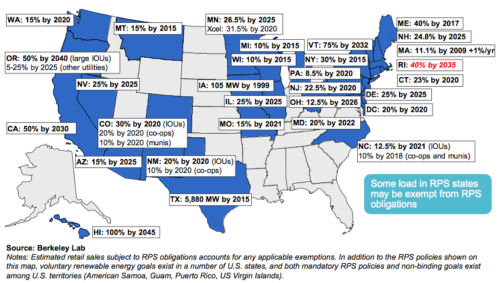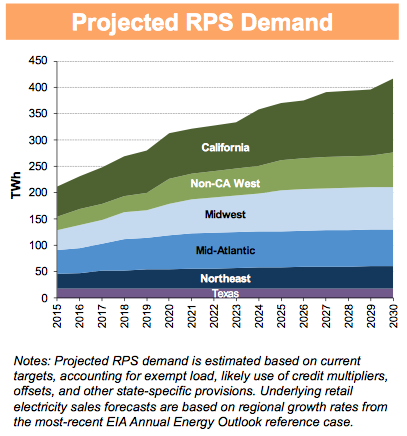Renewable Portfolio standards have been around for more than 20 years, but are they still relevant? A recent webinar hosted by Vote Solar presented information from the Lawrence Berkeley National Laboratory to determine if RPS were “past their prime or primed for progress.” Here is a summary of the information discussed.
Renewable Portfolio Standards (RPS) require utility companies to source a certain amount of the energy they generate or sell from renewable sources such as wind and solar. They create short-term targets for utilities to gradually increase their renewable energy generation, which results in a significant long-term increase for the entire state. RPS policies vary among states with differences in clean energy standards, non-binding renewable goals and carve-outs that include more specific requirements for renewable energy generation.
RPS policies were first enacted during the 1990s to spur the growth of renewable energy usage in the U.S. Currently, 29 states plus D.C. have RPS policies. This does not include other states who have non-binding renewable energy goals.

Since their establishment, RPS policies have provided many benefits, such as creating jobs in the renewable energy sector, saving consumers money on utility bills and encouraging economic development. Since 2000, about 60% of the growth in U.S. renewable energy generation can be attributed to RPS policy requirements.
With the exception of Vermont in 2015, new RPS policies haven’t been enacted in about six years. Though the enactment of new policies has declined, states are constantly making revisions to their existing policies.
Most revisions aim to strengthen a state’s existing policy. The most common one that states are making is creating resource-specific carve-outs, especially regarding solar and distributed generation. Eighteen states and D.C. have made this sort of addition. Also, about half of all states with policies have at some point extended their overall RPS targets, even just within the past year. California recently increased its RPS to 50% by 2030, while Connecticut created a residential solar program to have 300 MW installed by 2022. Hawaii strengthened its RPS to 100% by 2045 and Vermont created a new RPS with a distributed generation carve-out.
However, there have also been policy changes that hurt or hinder renewable energy development, such as bills to repeal, reduce or freeze RPS programs. So far, only Ohio and Kansas have passed this sort of bill. Kansas is one of the only states where recent legislative activity resulted in a weakened bill; they repealed its RPS policy and replaced it with a voluntary renewable energy goal.
Still, many states are beginning to approach their RPS targets. Eight states have reached, or even surpassed, their targets—five doing so in 2015. Most others will reach their goals in 2020 and 2025. But despite the nearing targets, the demand for RPS policies is still expected to grow. The total U.S. RPS demand is projected to increase from 211 terawatt-hours (TWh) in 2015 to 417 TWh in 2030. To keep pace with this demand growth, the total U.S. renewable energy supply would need to grow 12.2% by 2030. This is equivalent to installing an additional 55 GW of renewable energy capacity by 2030.
The impact that state RPS policies will have in the future depends on several factors. Within states, the role of RPS policies are subject to certain legislative and legal challenges to state RPS programs, whether states extend RPS targets as their final years approach and revisions to policies in response to an ever-changing market. As a nation, policies will be affected mainly by the related issues affecting renewable energy deployment, including integration, siting and net-metering.


Note NY 30% by 2015 which has passed with the state not reaching the mid 20%’s (even when starting off with 19% legacy hydro.
The point is RPS are well and good but without teeth behind it ( like in the new 50% mandate requiring utilities to pay into a SREC) lofty goals will come and pass without success.
We can do better in NY, where the electrical revolution started in 1882 with Thomas Edison’s first commercial utility power plant and also 2 years later with the installation of a residential photovoltaic system in NYC.
Edisons profetic quote years later tells it all “We are like tenant farmers chopping down the fence around our house for fuel when we should be using Natures inexhaustible sources of energy — sun, wind and tide. … I’d put my money on the sun and solar energy. What a source of power! I hope we don’t have to wait until oil and coal run out before we tackle that.”